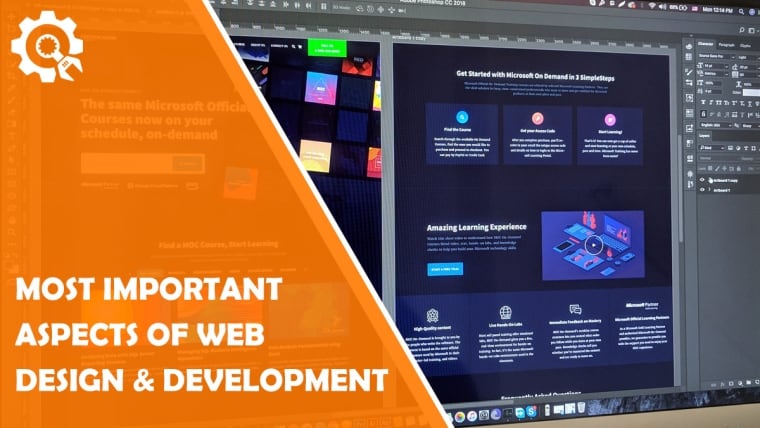In today’s digital world, web design and development play a vital role. They shape how websites look, function, and engage users, impacting businesses and individuals.
This article explores the most important aspects of web design and development, including interactive design, coding, and optimization.
If you want to create good websites, it’s essential to understand the vital elements. This applies to designing slot apps, social media pages, and sports websites. To know how to create engaging online experiences, let’s explore some important aspects.
What is Web Design?
Web design encompasses the creative and user-centric aspects of crafting websites for the online world. The main goal is to improve the user experience instead of focusing on software development.
In the past, it was focused on making desktop websites. But now, mobile and tablet browsing is also essential. Web designers shape a website’s appearance, including color choices, fonts, and images.
They also handle the layout, organizing, and effective structuring of information. Several features characterize effective web design. Some include user-friendliness, visual appeal, and alignment with the target audience and brand. Simplicity often takes precedence to remove distractions and potential sources of user frustration.
Two popular ways to make websites work well on computers and mobile devices. These methods make sure websites work well on different devices and screen sizes.
One of the most important aspects of web design and development is ensuring a seamless user experience, which can be achieved through intuitive navigation and responsive design. Creating a detailed UX wireframe is crucial, as it helps map out the structure and functionality of the website before development begins, ensuring that the end product meets user needs and expectations.
Responsive Design
It represents a modern approach to web content presentation. It easily adapts to different devices’ screen sizes and resolutions. We can adjust the content layout to provide the best viewing experience using viewport breakpoints.
These are predetermined thresholds where the structure is modified. The beauty of a responsive structure lies in its ability to cater to an array of devices. This includes tablets, smartphones, and desktop computers, regardless of screen dimensions.
Designers own the creative freedom to establish rules within a responsive layout. They govern content flow and layout transformations depending on the screen size. Imagine this scenario: you access a responsive website on your desktop and decide to resize the browser window.
As if by magic, the content reorganizes itself to harmonize with the new window size. The website checks how much space is on a phone and arranges itself to be easy to use. The responsive structure ensures your web content looks great and works well on all devices and screen sizes.
Adaptive Design
It’s about making websites work well on different devices, like responsive design. The main difference lies in how they do it.
With a responsive layout, the content remains the same for every device, but how it’s arranged changes. So, you see the same things whether you’re using a big desktop screen or a small smartphone.
Now, adaptive design takes things up a notch. It doesn’t look at the device; it also pays attention to what’s happening around the user. This means it can create experiences that make sense for the situation. For example, if it notices slow internet or you’re on a mobile, it might show a simpler page version, like a summary, instead of a big, complex image. Or, if you’re on an old phone with a tiny screen, it might make buttons bigger to make things easier to tap.
Adaptive design tailors websites to meet your needs, no matter how you access the web. It’s important to consult a digital development agency to make sure all your layouts function seamlessly across different devices and screen sizes. They can also help optimise performance and accessibility to enhance user engagement and satisfaction.
What’s the Future of Web Design?
The horizon of its future holds great promise, poised to ignite innovation in creativity, technology, and user experiences. The shifting digital terrain is leaving its mark in profound ways.
Foremost among these shifts is the growing emphasis on mobile-first and responsive design. They’re mirroring the ascendancy of smartphones and mobile devices.
The impending influence of AI and machine learning in web design is undeniable. It’s enabling personalized user journeys and chatbots and harnessing data for advanced insights.
Augmented reality (AR) and virtual reality (VR) stand on the brink of revolutionizing the web. They offer immersive and interactive experiences. Sustainability and inclusive design are gaining ground.
The digital landscape is changing and evolving every day. The future holds the promise of more accessible, engaging, and conscious online experiences. The vanguards of this transformation are the designers and developers, driving innovation and reshaping the way we engage with the internet in the years ahead.
Conclusion
In the world of design and development, change is constant. The field keeps evolving by making websites work well on all devices and using AI, AR, and VR. Designers and developers are the trailblazers, using creativity and technology to lead the way. We’ve explored the essentials. From user-centered design to sustainability. There are exciting possibilities in the future of web design and development.
Think mobile-first, AI-driven personalization, and immersive experiences. Staying up-to-date with trends and focusing on user satisfaction will be crucial.
Web design and development are the building blocks of our online experiences. Understanding these essentials is vital whether you’re a pro or just curious. It’s a journey that blends art, tech, and creativity, and it’s bound to keep making our online world better in the future.
